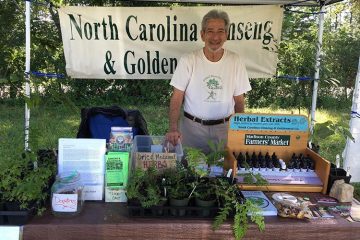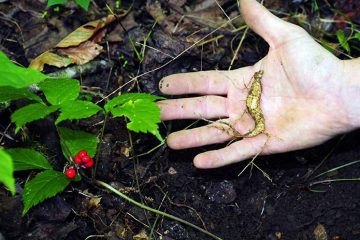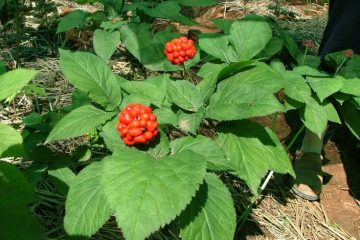Mountain Xpress, by Carrie Eidson, May 20, 2015
mountainx.com/living/overharvesting-of-forest-plants-calls-for-mindful-consumers

Bart Zink first learned about wild harvesting from his father, hunting for morel mushrooms in rural Michigan. Now he hunts for wild mushrooms and ramps on the steep slopes of Western North Carolina. “You kind of have to go out into uncharted territory now,” Zink says. “It’s like finding a needle in a haystack, and you might not even be looking in the right haystack.”
People in the WNC mountains have been foraging in the woods for generations, seeking out edibles like mushrooms and ramps or medicinals like bloodroot, goldenseal, black cohosh and — perhaps most famously — ginseng. But with interest in these plants rising and more novice foragers venturing into the woods, the plants are becoming harder and harder to find.
“Ramps have been over hunted in certain areas,” Zink points out. “When I was in Barnardsville recently, I saw carloads of people who were going out into the woods with big grocery bags.”
The rise in popularity of tailgate and farmers markets is also putting an increased demand on these forest plants, and according to Jeanine Davis, associate professor and extension specialist with N.C. State University, many people don’t understand where the plants they buy are coming from.
“That’s always a shock to folks when I show them that most of this black cohosh, bloodroot or goldenseal, there’s not a farm where it came from,” Davis says. “People are walking out in the woods and finding it, and that’s not necessarily bad, but we do need to have some controls on this, or those plants could be gone.”
As gourmet restaurants tout the flavors of wild edibles and herbalists extol the health value of native medicinals, interest in these plants is only continuing to grow. But what is the responsbility of the recreational forager or even the consumer? When browsing the stands at the farmers market or the shelves in an herbal shop, how can you know if the plants and products you’re purchasing came from overharvesting or even poaching? How can you know if you’re encouraging a sustainable, local economy or contributing to a growing problem?
An unsustainable demand
Davis notes that one of the first things to understand, is that not all these plants come from foraging. Some local growers are taking up the task of cultivating in their forests, but growing sustainably comes with a price.
“I can take you into the woods and show you people growing these plants all over the place,” Davis notes. “But [the question] is, ‘How do you do it so that you make money? How do you charge enough? What kind of yields do you need?’”
Ginseng is a potent example. Wild ginseng roots fetch a high price on the herbal market, but they are also small, light in weight and take years to mature to their full potency.
“Think of how old this little root is, but also think of how many of these it takes to make a pound,” Davis notes while examining a wild root. “People say, ‘Oh, ginseng’s going for $1,000 a pound,’ but that’s dried. Think of how many of these it takes to make a pound. It weighs basically nothing.”
Some growers have turned to simulated conditions and, in many cases, large amounts of fertilizers and pesticides to produce a plant that can be harvested quickly, but is compromising quality, says Robert Eidus of Eagle Feather Organic Farm in Marshall.

“The growing period for the cultivated [variety] is three to four years, and they grow for weight,” Eidus says. “With the wild [variety], it takes 6 1/2 to seven years to get the full constituents, and they’re not growing for weight; they’re growing for age. You’ve really got two different products that are confused by the public as the same thing.”
Examining the root of a cultivated ginseng plant will easily show you the difference. The wild root is small and gnarly with a long neck, whereas the cultivated root is larger and smoother. But most consumers aren’t buying ginseng roots — they’re buying dried and ground up ginseng that comes in a bottle that tells you little or nothing about where the plant came from.
Some growers, including Eidus and other members of the N.C. Ginseng Association, grow in the forest or by simulating wild conditions without the use of chemicals. But these growers are selling their ginseng at a higher price in smaller markets, not growing quickly to sell in bulk to high-volume buyers in the U.S. or Asia. Eidus asserts that most of the ginseng grown in America, and most of what you’ll find in herbal stores — particularly large chains — is exposed to chemicals and harvested too young. “You can’t get away from that fact,” Eidus says. “There’s just a small amount of really good ginseng in the world, in my estimation.”
A desire for the more potent wild ginseng has led to the rise of poachers who take the plant from private and federal lands without permission, hoping to make a quick buck. And when money is involved, so is greed — and little incentive to leave any of the plant behind.
“The mental attitude seems to be, ‘If I don’t take it then that jerk over there is going to take it, and I’m not going to let him have it, so I’m going to take it all,’” Eidus says. Though he says many ginseng dealers have a “sixth sense” that a plant has been poached, it’s often impossible to know for sure.
“The plant is definitely endangered and going downhill,” Eidus adds. In order for a wild patch of ginseng to be considered sustainable it should have about 75 plants in it, he adds. But, “You don’t see that anywhere anymore.”
Ginseng isn’t the only plant facing limited supply and high demand. Eidus and Davis say goldenseal and lady slippers — often used in tinctures — are both highly threatened by overharvesting.
Growing solutions
So, what do you do to make sure you’re being a conscientious consumer? Davis says to start by reading the labels: Look for the USDA Organic label to know no chemicals were used in production or the Blue Ridge Naturally label to know that any wild-crafted ingredients were sourced sustainably.
But most importantly, Davis says, ask questions: Ask where the plant came from, how it was grown and what the seller is doing to prevent overharvesting.
And once you find a grower or seller you trust, be willing to pay more for their products, Davis adds. “If we want to support the farming of these plants, we need to be willing to pay a little bit more,” she says. “It’s going to cost more for someone to farm something than to go out on property they don’t own and just gather it all up.”
For those searching out these plants in the woods, local forager Michael Gentry says to take less than a quarter of what you find and remember the Rule of Three: Leave some for the wild animals, some for re-seeding and some for other foragers.
Of course, there’s another option for those who are looking for a modest supply of these plants or who are interested in preservation efforts: You could always grow your own. Many forest plants can thrive on steep slopes unsuited for other gardening, Davis points out. And Eidus adds that ginseng and goldenseal can happily grow together in a raised bed with good drainage and good shade. “It’s my answer to suburbia,” he says. “[You] don’t have to have a forest.”
Davis adds that many people in the area are inheriting land that they have no interest in farming but still hope to keep. Modest harvesting of forest plants can provide additional income to cover property taxes. And creating contracts or agreements with others who would responsibly forage on your land in exchange for caring for the property is a way to protect the plants and keep your land in good condition.
The main thing, though, is to be mindful. Whether you’re shopping at the farmers market, exploring in the woods or even beginning a construction project on your property, Eidus says to be aware of the unique and fragile nature of the plants around you.
“We have not dealt with these plants correctly,” Eidus says. “We don’t really care what’s in the forest, and that’s unfortunate because we’re losing this connection to these plants that was really strong just three or four generations ago.”






